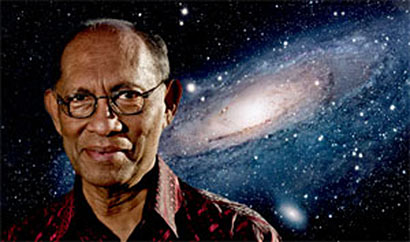CHANDRA WICKRAMASINGHE COMING TO SRI LANKA TO GATHER FURTHER INFORMATION

By Walter Jayawardhana – Pix by University of Buckingham
Professor Chandra Wickramasinghe, Director of the Buckingham Center for Astrobiology in the United kingdom will fly to Sri Lanka for obtaining further information of the Polonnaruwa Meteorite and meeting some Sri Lankan scientists for discussions over his team’s findings over this weekend.
He told this correspondent, “We are carrying out more tests and are more convinced that the Peradeniya criticism has no validity, The meteorite is of an unusual type, but all the evidence is that it fell from the skies. No one can challenge that diatoms are present inside this rock. The claim that it is a piece of Earth rock struck by lightening does not square up with the amount of volatile gases that are trapped in the matrix, and presumably the gas that caused the farmers wife to faint. At a temperature of 1500 degrees all such organics would have been evaporated. The piece I have is still out gassing.”
Wickramasinghe was responding to the criticism of some university dons from the Geology Department of the Peradeniya University that Polonnaruwa Meteorite could well be terrestrial clay subjected to the high heat of lightening.
He at a different occasion said that the Peradeniya dons could be well looking at an altogether different piece of rock.
He said, “Sir Arthur Clarke wrote a preface to one of my books thus: “Bohr is reported to have said to a fellow scientist ‘We all agree that your theory is crazy – but we don’t think it’s crazy enough to be true.’ Well, I think that Chandra’s theory is crazy enough to be true, and I’m more and more convinced now that life has spread throughout the universe by the very mechanism he proposes..” Arthur C. Clarke, 2001.” Bohr was a celebrated physicist from Denmark.
He added in his message to me, “The thought of having these fantastic living structures in a rock that hit Sri Lanka, the country of my birth, does indeed make me shudder! Crazy! But they are certainly there. My diatom expert friend tells me that some of the diatoms are not soil diatom, many are fresh water diatoms, and some are of an unknown genus. It is looking like we have got here a sample of the bottom of a dried-out cometary lake or pond. We are conducting more tests to make sure. In particular we are looking at isotope signatures. I am hoping to go to Sri Lanka next weekend to get more information and to discuss our findings with the scientists there.”
He was responding to some criticisms of the Polonnaruwa Medteorite was no meteorite but dried out earth clay by lightening.
In a news broadcast by a TV channel Professor Rohana Chandrajith made the criticism and Professor Athula Senaratne collaborated with him.
Chandra Wickramasinghe added in another message: “The clay minerals that are present in the meteorite most probably belonged to a comet. Clay minerals have been identified in the studies of comet Tempel 1. I think, from the sample we studied, it would appear that this is a fragment of a comet crust – the bottom layers of a cometary lake in which living organisms were present. Further tests would establish whether or not the piece we have is of Earth origin or comes from space. I don’t see how clay lumps could be scattered on the surface where this meteorite was collected, and how lightening could have struck to produce what we have. Of course the extraterrestrial life theory would be challenged by conservative scientists, but extraordinary and implausible assumptions seem to be needed. How also do we explain the occurrence of this field of meteorites after a fireball event?
We are carrying out more tests and are more convinced that the Peradeniya criticism has no validity, The meteorite is of an unusual type, but all the evidence is that it fell from the skies. No one can challenge that diatoms are present inside this rock. The claim that it is a piece of Earth rock struck by lightening does not square up with the amount of volatile gases that are trapped in the matrix, and presumably the gas the caused the farmers wife to faint. At a temperature of 1500 degrees all such organics would have been evaporated. The piece I have is still out gassing.”

Latest Headlines in Sri Lanka
- Suspects identified in clash involving Yoshitha Rajapaksa at Colombo nightclub March 24, 2025
- Cannabis farm hidden among tomatoes uncovered in Wellawaya March 24, 2025
- Sri Lankans to soon pay traffic fines online via GovPay March 24, 2025
- Sri Lanka faces surge in gun violence: 22 dead this year March 23, 2025
- Three arrested for soliciting bribe to issue Ayurvedic medical certificate March 23, 2025



Sir,
You are bit willing and bias to say and accept at any time that life is there in another planet.
Peradeniya geologists confirm that algae you found are a local ones, not of another planet.